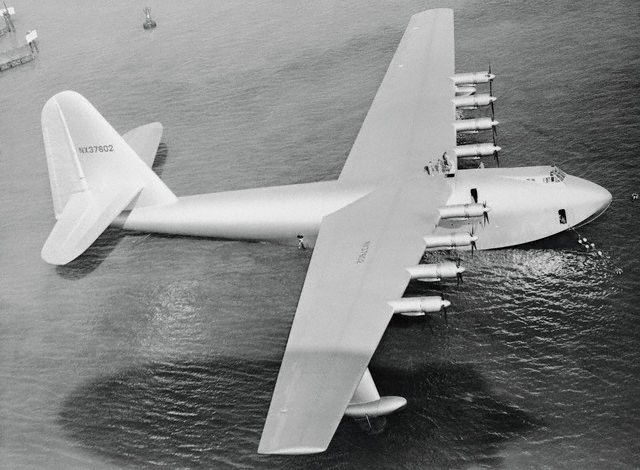Fun Facts About the Spruce Goose
Names: Hughes Flying Boat H-4 (HK-1) Hercules (“Spruce Goose”)
Description: The Hughes Flying Boat is a cargo-type seaplane designed to transport men and materials over long distances. This aircraft is of a single hull, eight-engine design, with a single vertical tail, fixed wing-tip floats, and full cantilever wing and tail surfaces. The entire airframe and surface structures are composed of laminated wood (primarily birch). All primary control surfaces except the flaps are fabric covered. The hull contains two areas: a flight deck for the operating crew and a large cargo deck. A circular stairway provides access between the two decks. Below the cargo deck are fuel bays divided by watertight bulkheads.
Largest wingspan: 319 feet, 11 inches with a wing area that covers 11,430 square feet
Features full cantilever wing and tail surfaces.
Tallest aircraft: 79 feet, 3 3/8 inches
Length: 218 fee 6 ¼ inches
Record setting: Largest seaplane and largest wooden aircraft: the entire airframe is composed of laminated wood. Primary control surfaces, except the flaps, are fabric-covered. The most reciprocating horsepower ever installed in an aircraft.
Power: Eight Pratt & Whitney R-4360, 3,000 horsepower engines
Propellers: Eight, 17 feet, 2 inch diameter
Weight, Empty: 300,000 pounds
Weight, Loaded: 400,000 pounds (maximum take-off weight)
Capacity: 750 troops or two Sherman tanks
Normal Crew: 18
First And Only Flight: November 2, 1947
Why built: In July 1942, the world was at war. America had just lost 800,000 tons of her supply ships to German U-boats. Henry Kaiser, famed industrialist and builder of “Liberty” ships, proposed a fleet of flying transports to safely move troops and material across the Atlantic. Kaiser approached Howard Hughes with his idea. Together they formed the Hughes Kaiser Corporation and obtained an $18,000,000 government contract to construct three flying boats.
Hughes and his team of skilled engineers designed a single hull flying boat capable of carrying 750 troops. The plans called for eight 3,000 horsepower engines, a mammoth fuel storage and supply system, and wings 20 feet longer than a football field. They called the prototype aircraft the HK-1, standing for the Hughes Kaiser design number one.
Delays and Constraints: Encountering and dealing with tremendous design and engineering problems, the Hughes team developed new concepts for large-scale hulls, flying control surfaces, and complex power boost systems. Hughes engineers created the first “artificial feel system” in the control yoke, which gave the pilot the feeling he was flying a smaller aircraft, but with a force multiplied two hundred times. For example, for each pound of pressure exerted on the control yoke by the pilot, the elevator received 1,500 pounds of pressure to move it.
Adhering to the government mandate not to use materials critical to the war effort (such as steel and aluminum), the Hughes team constructed the Flying Boat out of wood. Hughes perfected a process called “Duramold” to create almost every part of the plane. Originally developed by Fairchild Aircraft Company, Howard Hughes purchased the rights to use Duramold in large aircraft. The Duramold process is a plywood-like series of thin wood laminations, with grains laid perpendicular to each other. Workers permeating the laminations with plastic glue, then they shaped and heated the pieces until cured. The result is a material that many engineers agree is both lighter and stronger than aluminum.
All of the research and development that went into the new seaplane delayed the construction process. In mid 1944, Henry Kaiser withdrew from the project, and Hughes took personal responsibility for all facets of the flying boat’s design and production. He renamed the gigantic seaplane H-4, representing his aircraft company’s fourth design.
After the war’s end in 1945, criticism of the project mounted. The Flying Boat prototype had exceeded the government’s funding allowance and the U.S. Senate formed an investigation committee to probe alleged misappropriation of funds. Hughes invested $7,000,000 of his own into the project to keep it going. While Hughes testified before the investigative committee in Washington, D.C., the Hughes team assembled the Flying Boat in the Long Beach dry dock. After his interrogation, Hughes was determined to demonstrate the capability of his Flying Boat. He returned to California and immediately ordered the seaplane readied for taxi tests.
Proof of Concept: On November 2, 1947, a crowd of expectant observers and newsmen gathered. With Hughes at the controls, the giant Flying Boat glided smoothly across a three-mile stretch of harbor. From 35 miles per hour, it cruised to 90 during the second taxi test when eager newsmen began filing their stories. During the third taxi test Hughes surprised everyone as he ordered the wing flaps lowered to 15 degrees and the seaplane lifted off the water. He flew her for a little over a mile at an altitude of 70 feet for approximately one minute. The short hop proved to skeptics that the gigantic craft could fly!
Special thanks to www.sprucegoose.org






No comments:
Post a Comment